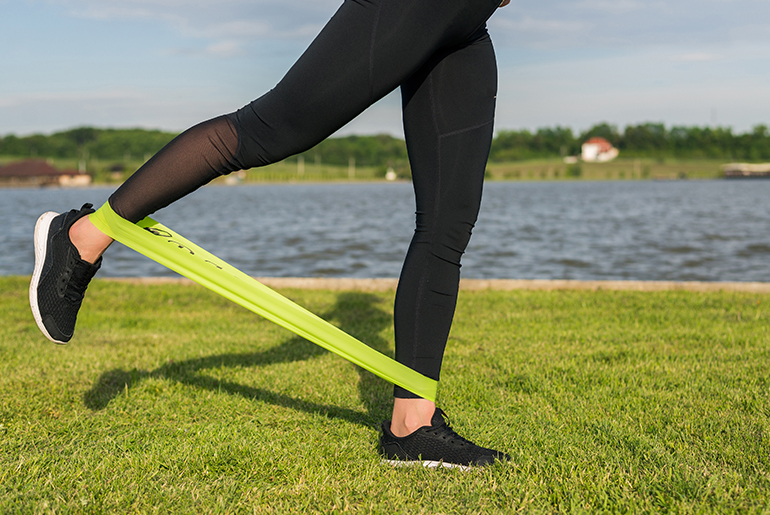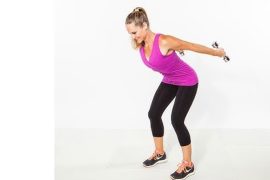If you are thinking to make your workout efficient in the comfort of your home, then resistance bands are the ones that you should consider incorporating into your workout regime. Performing resistance band workouts play a pivotal role to suffice your regular weight training or resistance training. With the usage of resistance bands, it is possible to grow every major muscle group with little more than a solitary strip of elastic.
Besides all, there is no beating the portability of the band. The bands are ideal for home use, outdoor workouts, hotel sessions, and also even for making use of a tight space at the gym. Loop it around your bedpost, hang it from a tree branch, or anchor it beneath your feet for a tough total-body workout.
Benefits of Resistance Band Workouts
- Improves Flexibility – Resistance bands improve flexibility. Using these bands in a 5-week training program improves flexibility and range of motion.
- Builds strength – Lifting heavy stuff builds muscle strength by providing resistance for your muscles to work against. And resistance bands can provide that benefit without the need for heavy, expensive equipment.
- Convenient and Easy – Many people give up weight training because it can be pretty inconvenient. You can’t always go to the gym or you may not have space to store a large set of dumbbells. But resistance bands are basically pocket gym equipment, that can be carried anywhere, and thus workouts can be performed without any hassle.
- Keeps you Safe – One reason that resistance bands are a good option for older adults and injured folks is that they are considered a safer alternative than traditional weights. With proper form, you control the difficulty and resistance of the elastic band that you are using.
Types of Resistance Bands
- Power Resistance Bands – This type of resistance band is essentially like massive rubber bands. They are continuous flat loops that can be used for a variety of purposes. This type of band is ideal to perform exercises such as bodyweight resistance, full-body workouts, physical therapy, warm-ups, and static stretching.
- Tube Resistance Bands – Tube resistance bands have handles that attach to both ends and they are made to mimic gym machines and dumbbell exercises. They easily anchor to the door or a bar/pole. This band is good for chest presses, curls, back rows, shoulder presses and other exercises that involve pressing and pulling.
- Light Therapy Resistance Bands – This type of band is very long, lightweight and thin. They are ideally used for regaining strength after an injury and also for those elderly people who want to have a very low-impact workout. They are also effective when combined with Pilates and fat burner workouts, where all you need is a little added resistance to get a really good burn.
- Figure 8 Resistance Bands – This band has soft handles at the top and bottom of the figure 8 shape. They stretch as far as you would need them to, thus making you able to target both your upper and lower body. Figure 8 bands can be used similarly to mini bands for lateral movements, and similarly to tube resistance bands to mimic machine and dumbbell exercises. They are best used for pushing and pulling exercises in the sagittal and lateral planes of motion.
Association of Colour With Resistance Bands
Resistance bands come in different colours and are extremely versatile, lightweight and easy to take in a gym bag. Being the best home gym equipment, resistance bands are made of latex and are highly elastic and odourless. These bands are a great way to improve your flexibility and joint mobility. Resistance bands come in five colours namely yellow, green, red, blue and black.
- Yellow Bands – Yellow resistance bands are meant for beginners, as they offer light resistance and are very stretchy. These colour resistance bands are used to do some exercises which use joints such as shoulders and shins.
- Green Bands – Green resistance bands are meant for a step up from the beginner, as they offer medium resistance and have more tension than yellow resistance bands. These colour resistance bands are used to work your muscle like the biceps and triceps.
- Red Bands – Red resistance bands are meant for a bit higher level, as they offer a higher level of tension than the green ones. These colour resistance bands are used to work your legs, back, and chest.
- Blue Bands – Blue resistance bands are meant for stronger people, as they offer heavy resistance. These colour resistance bands are used to work on larger muscle groups, such as the legs, chest, and back.
- Black Bands – Black resistance bands consist of the heaviest resistance to pull and stretch. Exercising with this band is challenging compared to other colour-coded bands. These colour resistance bands are used to work on large muscles with greater tension intensity.
Best Resistance Band Workouts
1.) Front squat – The front squat is one of the best resistance band workouts that you can perform in the comfort of your home. Your butt, both sides of your thigh, and your hamstrings are going to thank you for this particular exercise. Front squats can also provide a strong boost to your groin, hip flexors, and calves.
Steps To Perform
- Stand on the band with your feet slightly wider than shoulder width.
- Holding a handle in each hand, bring the top of the band over each shoulder. If the band is too long, secure it in place by crossing your arms at your chest.
- Lower as if you’re sitting down in a chair. Keep your chest up, abs firm, and feet flat.
- Rise back up to the starting position.
- Repeat for 8–12 reps.
2.) Leg Extension – The leg extension is one of the best resistance band workouts that you can perform in the comfort of your home. This exercise is considered the best for strengthening knee muscles, especially quadriceps and hamstring muscles.
Steps To Perform
- Anchor a loop band in a low position on a support (like an incline bench), looping the other end around your ankle with the band positioned behind you.
- While seated, step away from the anchor to create tension on the band, and position your feet hip-width apart.
- Shift your weight to your left foot and lift your right leg from the floor.
- Extend your knee until it straightens out in front of you.
- Slowly return to the starting position.
- Repeat for 8–12 reps before switching legs.
3.) Leg Curl – Leg Curl is one of the best resistance band workouts that you can perform in the comfort of your home. Being identical to leg extension exercise, this exercise is considered the best for strengthening knee muscles, especially quadriceps and hamstring muscles.
Steps To Perform
- Lie face down and loop a band around your right ankle, anchoring it to a stable object close to the floor for support.
- Scoot away from the anchor to create tension.
- Tighten your core and bend your leg at your knee, bringing your heel toward your glutes as far as you can comfortably go.
- Slowly return your leg to the starting position.
- Repeat for 10–15 reps, then switch sides.
4.) Standing adduction – Standing adduction is one of the best resistance band workouts that you can perform in the comfort of your home. Performing this exercise boosts your hips, groin, and inner thigh, and the adductor movement stands tall.
Steps To Perform
- Anchor a loop band at ankle height to support and stand with your right side facing the support, wrapping the free end around your right (outer) ankle.
- Stand perpendicular to the band and step away from the support to create some tension.
- From a wide stance, get into a quarter squat.
- Pull your right leg toward your left, working against the resistance.
- Slowly return to the starting position. Repeat for 12–15 reps before switching sides.
5.) Plantar flexion – Plantar flexion adduction is one of the best resistance band workouts that you can perform in the comfort of your home. Performing this exercise improves your ankle’s flexibility. This is highly crucial to handle any sudden jerk during walking or running your ankle.
Steps To Perform
- Sit on the floor with one leg straight out in front of you, one bent.
- Hold both ends of a resistance band, wrapping the middle around the ball of your foot.
- Sit up straight and flex your foot forward by pointing your toes away from you.
- In a controlled movement, bring your toes back up, flexing them toward your knee as far as it’s comfortable.
- Slowly return to the starting position.
- Do 10–12 reps on each side.
Disclaimer:
The information contained in this article is for educational and informational purposes only and is not intended as a health advice. We would ask you to consult a qualified professional or medical expert to gain additional knowledge before you choose to consume any product or perform any exercise.








